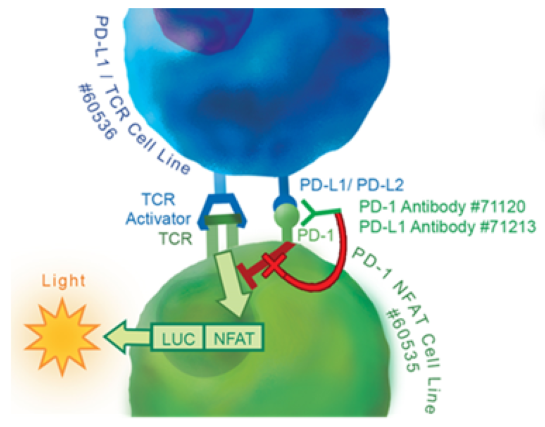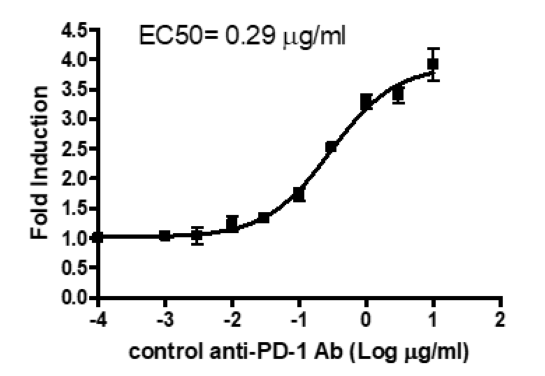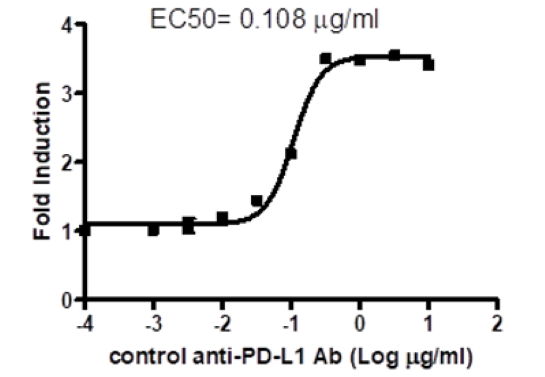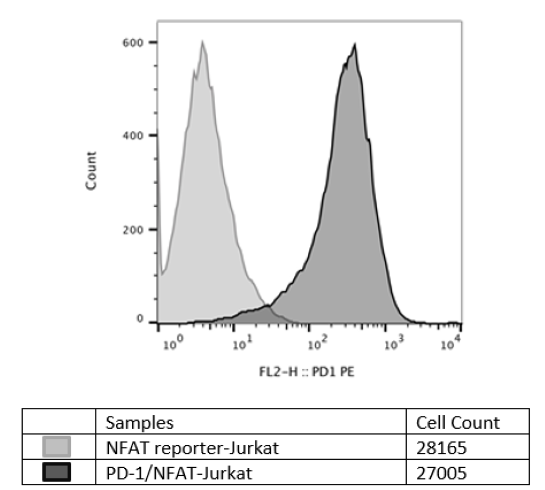Growth Arrested PD-1 / NFAT Reporter Jurkat Cell Line
Growth Arrested PD-1 / NFAT Reporter Jurkat Cell Line is a Jurkat T cell cell line expressing firefly luciferase under the control of NFAT response elements with constitutive expression of human PD-1 (Programmed Cell Death 1, PDCD1, SLEB2, CD279, GenBank Accession #NM_005018).
Note: These cells are unable to complete mitosis and are suitable for single use assays. For proliferating cells, please use our PD-1 / NFAT Reporter Jurkat Cell Line (BPS Bioscience #60535).

Figure 1: Illustration of the mechanism of action of Growth Arrested PD-1 / NFAT Reporter Jurkat Cell Line in a co-culture assay.
The TCR activator present at the surface of PD-L1/TCR Activator CHO cells stimulate TCR in Jurkat T cells, whereas overexpression of PD-L1 on the CHO cell line engages Jurkat PD-1, blocking TCR activation signaling and preventing activation of NFAT. Addition of a neutralizing anti-PD-1 or anti-PD-L1 antibody to the co-culture releases the PD-L1/PD-1 complex and results in TCR activation and increased NFAT activity, which translates into increased luciferase reporter signal.
Materials Required for Cell Culture
| Name | Ordering Information |
| Thaw Medium 2 | BPS Bioscience #60184 |
Materials Required for Cellular Assay
| Name | Ordering Information |
| PD-L1/ TCR Activator CHO Cell Line OR PD-L2/ TCR Activator - CHO Cell Line |
BPS Bioscience #60536 OR BPS Bioscience #79632 |
| Thaw Medium 2 | BPS Bioscience #60184 |
| Anti-PD-1 Neutralizing Antibody | BPS Bioscience #71120 |
| Anti-PD-L1 Neutralizing Antibody | BPS Bioscience #71213 |
| 96-well tissue culture-treated white clear-bottom assay plate | |
| ONE-Step™ Luciferase Assay System | BPS Bioscience #60690 |
| Luminometer | |
| Thaw Medium 3 | BPS Bioscience #60186 |
The cell line has been screened to confirm the absence of Mycoplasma species.
PD-L1 and PD-L2 binding to PD-1, a receptor expressed on T-cells, negatively regulates immune responses. PD-1 ligands PD-L1 and PD-L2 are found on the surface of most cancer cells, and their interaction with receptor PD-1 inhibits T cell activity and allows cancer cells to escape immune surveillance. This pathway is also involved in regulating autoimmune responses. Therefore, these proteins (termed immune checkpoints) are promising therapeutic targets for many types of cancer as well as multiple sclerosis, arthritis, lupus, and type I diabetes. Checkpoint inhibitors have remarkable efficacy in a wide range of cancer types and have revolutionized cancer treatment. PD-1 inhibitors nivolumab, pembrolizumab, cemiplimab and PD-L1 inhibitors atezolizumab, avelumab, and durvalumab are all FDA-approved drugs for immuno-therapy.
The cell cycle control system acts like a timer, or a clock, that sets a fixed amount of time for the cell to spend in each phase of the cell cycle. The four major phases of the mammalian cell cycle are G1, S, G2 and M phases. Cell-cycle arrest means the cell enters quiescent stage, where the cell is no longer able to undergo cell division.





